This article was co-authored by Jasper Sidhu, DC. Dr. Sidhu is a Chiropractor in Toronto with more than 20 years of experience. He received his DC from Canadian Memorial Chiropractic College in 1994, and later completed a 3 year Certification in Rehabilitation.
There are 10 references cited in this article, which can be found at the bottom of the page.
This article has been viewed 79,030 times.
Shinsplints, or medial tibial stress syndrome, refers to pain and inflammation from either overusing or repetitively straining the muscles that are attached to the shinbone (tibia) of your lower leg.[1] The condition commonly develops in runners, hikers, dancers and military recruits. Most cases of shinsplints resolve on their own after a few weeks of resting, although using a massage technique called myofascial release may be able to resolve the pain in your lower leg muscles quicker.
Steps
Using Myofascial Release for Shinsplints
-
1Identify what muscle(s) is involved. Shin splint pain is often deep and achy, and generated from the outside (lateral) mid-part of your tibialis anterior muscle, the main muscle next to your shinbone. Sometimes the tibial periosteum (the thin sheath of tissue that wraps around the shinbone) is also inflamed and painful. Typically, only one leg is involved and it's usually your most dominant one — the one you'd kick a ball with.[2]
- Feel around the mid-section of the muscle next to your shinbone for pain or tenderness. A shin splint is usually most tender roughly half-way between your knee and ankle joints.
- Be aware that you may come into contact with a trigger point, or more commonly known as a muscle knot. Pressing on a trigger point can lead to local tenderness, referred pain and a "twitch" response. Referred pain can sometimes be felt into the big toe when pressing into this area.[3]
- Typically there's only one tender and inflamed area, but you may find a couple different ones.
- Once you've identified the area, you'll know where to focus on with the myofascial release technique.
-
2Select a foam roller or tennis ball. Myofascial release is a deep tissue massage technique usually done with a firm foam roller or small ball, such as a tennis ball. The technique focuses on relieving pain thought to arise from the myofascia, which are the tough membranes that wrap, connect and support your muscles.[4] The membranous junctions are a little deeper under the skin, so myofascial release requires firm pressure to be able to impact them.
- Select a firm piece of foam roll, between 2–4 inches in diameter. It doesn't need to be any longer than 6 inches. The long ones are commonly used for yoga and are widely available in sporting good stores.
- Select the firmest type of tennis ball you can. Some hard rubber balls might be effective also, but make sure they're not much bigger than a tennis ball. Try a lacrosse ball.
- Professional massage therapists, chiropractors and physical therapists often use their thumbs or elbows to do myofascial release, but for self-treatment, foam rollers and tennis balls are more convenient and prevent a potential thumb sprain.
Advertisement -
3Get down on all fours on a firm surface. Find a firm carpeted surface (or you can lay a yoga mat down on wood or tile floors) and descend to your hands and knees. You could sit in a chair and push the foam roller or tennis ball into your sore shin muscles, but working with gravity and using your body weight is easier. The idea is to roll your shin over the foam/ball, instead of rolling the foam/ball over your leg.
- A hard tiled or wood floor is fine to use, but if may cause some discomfort in your knees as you kneel on it. Any padding you use is for the comfort of your knees, not effectiveness of the treatment.
- Before you kneel down, change into something that exposes your lower leg below your knee, such as a pair of shorts or Capri pants.
-
4Place the roller or tennis ball underneath your shin muscles. Once you're on your hands and knees, bend the sore leg with the shinsplints at the hip and knee and position the front of your shin onto your foam roller or tennis ball, which should be lying on the floor. For best balance, extend your other leg behind your (with your toes on the floor) and place both hands about 1–2 feet away from your bent knee and slightly ahead of it.
- In this position, you're initially supporting your body weight with your arms, but then once balanced, let your entire body weight push against the roller or ball.
- Once your entire body weight is balanced over the roller/ball, only your fingertips and toes of your other leg should be touching the floor.
- Wear some flexible rubber-soled shoes for best support and traction on the floor.
-
5Move your leg back and forth with sustained pressure. As your entire body weight is balanced over the roller/ball, rock yourself back and forth so that you can feel sustained pressure over the sore area of your shin. Any type of deep tissue massage, including myofascial release, can be a little painful, but this is where the old adage "no pain, no gain" applies. The focused, continual pressure and stretching caused by this therapy loosens up restricted and tight fascia and other tissues, which often leads indirectly to reduced pain and increased mobility in the muscle fibers.[5]
- Use your finger tips and toes to rock your body back and forth over the foam roller or tennis ball — maybe a little side-to-side motion will help too. If you find that the motion is too painful, move away to an area that is less tender and hold that position for 30 to 60 seconds. Then slowly edge your way to the area of pain.
- Keep the pressure over the roller or ball for about three minutes at a time, then take a five minute break and continue a few more times. Follow this routine on a daily basis.
- Deep tissue massage can release inflammatory by-products and lactic acid into your bloodstream, so always drink plenty of water immediately following any self-treatment to flush them out of your body.
-
6Apply some ice afterwards. After the myofascial self-treatment, which may take upwards of 20 minutes, put some crushed ice or something cold over your tender shin muscles for about 10–15 minutes.[6] Ice therapy is great for numbing musculoskeletal pain and reducing inflammation because it restricts local blood flow. If you don't have crushed ice, consider using ice cubes, a cold gel pack or a small bag of frozen veggies from the freezer. You can also freeze water in a paper cup, then peel off the paper around the lip of the cup and roll/slide the ice over your shins.
- To protect your skin from frostbite or irritation, always wrap ice in a thin towel or cloth before applying it.
- Wrap the ice therapy tightly against your shin with a tensor bandage for best results.
- Without combating the inflammation and tenderness with ice therapy each time, you may find the following day's myofascial session too difficult to do because of pain.
Avoiding Shinsplint Symptoms
-
1Change up your running routine. Shinsplints are often caused by either running (or walking) too much up hills, or on uneven terrain, or on particularly hard surfaces — such as asphalt or concrete. Therefore, alter your course and change the type of surface you run or walk on a regulate basis (every week). For example, switch sometimes to more forgiving terrain, such as grass, sand or a rubberized athletic track.
- If you run on a track, don't always run in the same direction. This can put an imbalance of forces on your lower legs. Make sure you change the direction in which you run on a regular basis.
- Alternatively, you might also need to reduce your mileage and the number of times you workout per week.
- Consider cross training. Mix in entirely different exercises in order to stay fit, but reduce the strain on your shin muscles.
- Swimming, cycling and rowing are good alternatives and also great at burning calories and maintaining a healthy weight.
-
2Lose weight if you're too heavy. Losing weight (if you're heavy) can help prevent shinsplints from developing because you'll put less pressure on the bones and muscles of your lower legs when walking and running.[7] Weight loss is best achieved by a combination of regular exercise and eating sensibly (consuming less calories). For most overweight women, consuming less than 2,000 calories per day will lead to 1–2 pounds every week even if you're only a light exerciser. Most heavy men will lose a similar amount of weight at under 2,200 calories daily.[8]
- Focus on better nutrition. Switch to lean meats and fish, whole grains, low-fat dairy, fresh fruits and veggies and lots of water for the results. Avoid processed foods and sugary drinks, particularly soda pop.
- Many overweight and obese people get flat feet and tend to over-pronate their ankles (they collapse and roll in), which are significant risk factors for developing shinsplints.
-
3Buy different shoes. Poorly fitting shoes or ones that are really heavy can also trigger the development of shinsplints. The tibialis anterior muscles work to raise your toes while walking, so if your shoes don't fit or are heavy, the muscles can get strained. Therefore, wear stable, supportive lightweight shoes that suit your sport or activity. Aim for no more than a 1/2 inch heel. If you're a serious jogger, replace your running shoes every 350 to 500 miles or after three months, whichever comes first.
- Get fitted by a shoe salesman later in the day because that's when your feet are at their largest, usually due to swelling and slight compression of your arches.[9]
- Get an evaluation done at a reputable running store if you're a serious jogger. You may be asked to run over a force plate that's hooked up to a computer, or get video taped while you're running as part of the assessment.
- Remember to tie your footwear tightly, because loose shoes or flip-flops put more strain / stress on your foot and lower leg muscles.
- If you are an over-pronator, look into getting supports (orthotics) for the soles of your shoes.
-
4Stretch your lower leg muscles. Stretching muscles of your lower leg (both front and back) can help prevent shinsplints. If you have shin pain, gently stretch your calves (and Achilles tendons) by wrapping a towel around your toes and then trying to slowly extend your leg while holding on to the ends of the towel. In addition, gently stretch the tibialis anterior muscle by kneeling on a padded floor with your feet together and toes pointed back, then slowly sit back onto your calves until you feel tension in the muscles of your shin.
- Hold each type of stretch for 20–30 seconds at a time, then relax and repeat three to five times per day or as needed.[10]
- Alternatively, while in a sitting position with your sore leg in the air, try tracing the letters of the alphabet with your toes. This is a good exercise that stretches and loosens up all the muscles of your lower leg.
- Focus on these stretches before running, jogging or going for long walks. It will help warm up the muscles and prevent shinsplints from flaring up.
-
5Strengthen muscles associated with shin splints. The best strengthening exercises to perform when you have shin splints is calf raises and hip abductor strengthening. Research has shown that these are the most effective strengthening exercises for shin splints and preventing shin splints.[11]
References
- ↑ https://orthoinfo.aaos.org/en/diseases--conditions/shin-splints/
- ↑ http://www.runnersworld.com/tag/shin-splints
- ↑ http://www.triggerpointbook.com/index.php?option=com_zoo&task=item&item_id=64&Itemid=161http://www.triggerpointbook.com/index.php?option=com_zoo&task=item&item_id=64&Itemid=161
- ↑ https://james-mccormack.com/advice-centre/shin-splints-massage/
- ↑ http://www.mayoclinic.org/diseases-conditions/back-pain/expert-answers/myofascial-release/faq-20058136
- ↑ https://my.clevelandclinic.org/health/diseases/17467-shin-splints
- ↑ http://www.mdguidelines.com/shin-splints
- ↑ http://www.healthline.com/health/lose-weight-calories#Guidelines2
- ↑ http://www.healthline.com/health/workplace-health/if-you-work-on-your-feet#TheRightShoe2
About This Article
To do a myofascial release self-massage for shin splints, select a foam roller or tennis ball to apply firm pressure to the myofacia, or membranes, under the muscles. Then, put on a pair of shorts or capris that exposes your lower leg, and get down on a firm surface. Next, place the roller or ball under your shin muscles and move your leg back and forth so you can feel sustained pressure over the sore area. After massaging your leg for 15 to 20 minutes, apply an ice pack or something cold to your shins for 10 to 15 minutes to reduce any inflammation. For more tips from our Medical co-author, including how to avoid shin splints with strengthening exercises, keep reading!
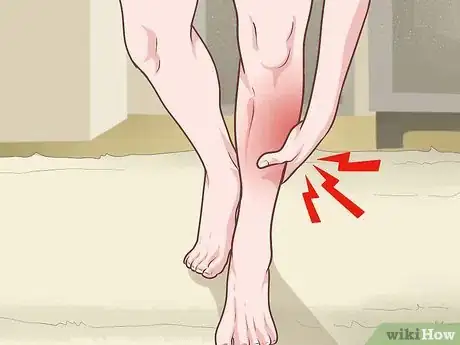

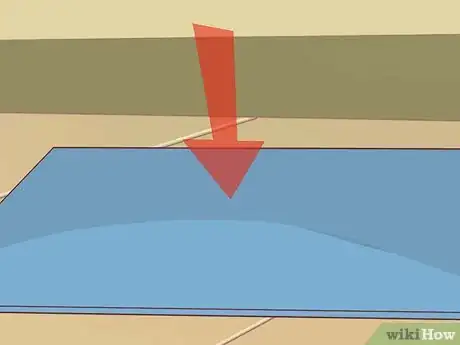
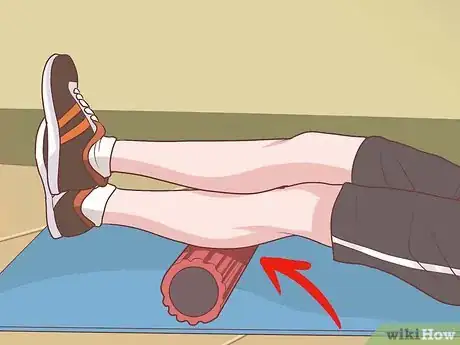
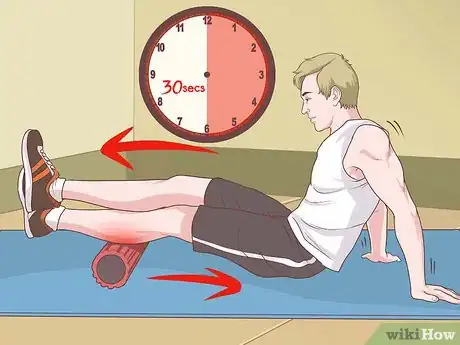
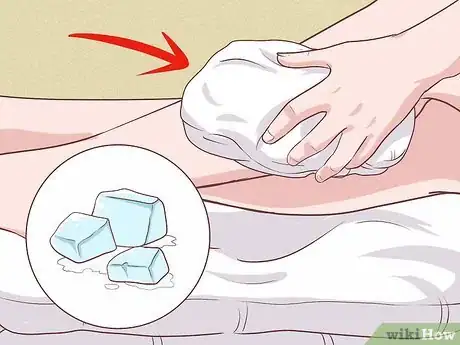
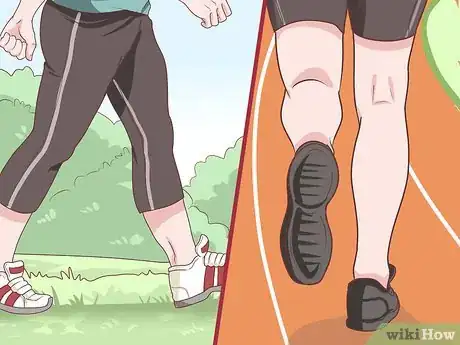
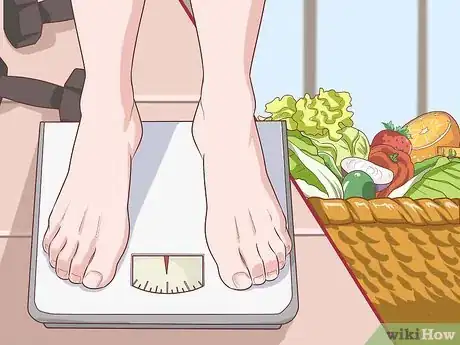
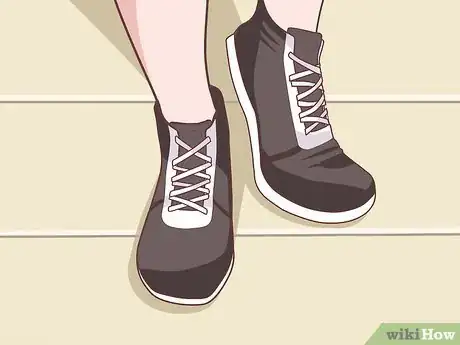
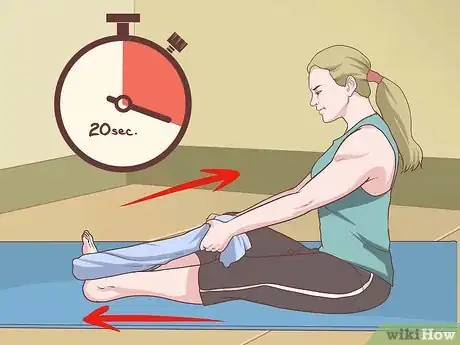
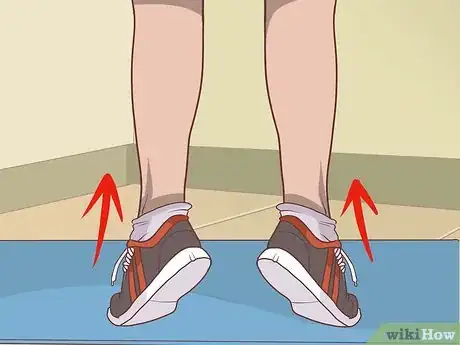

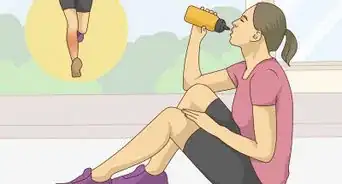
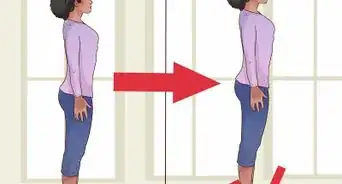
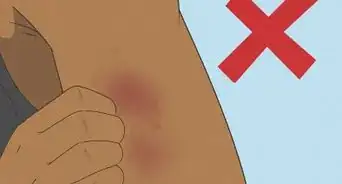
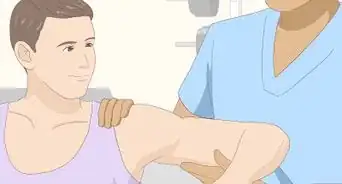



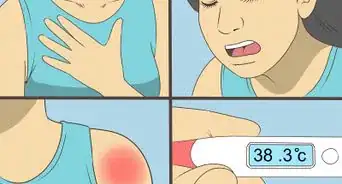
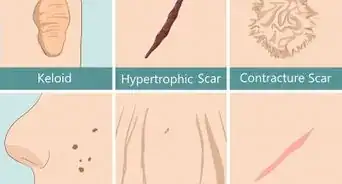











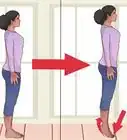
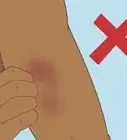



































Medical Disclaimer
The content of this article is not intended to be a substitute for professional medical advice, examination, diagnosis, or treatment. You should always contact your doctor or other qualified healthcare professional before starting, changing, or stopping any kind of health treatment.
Read More...